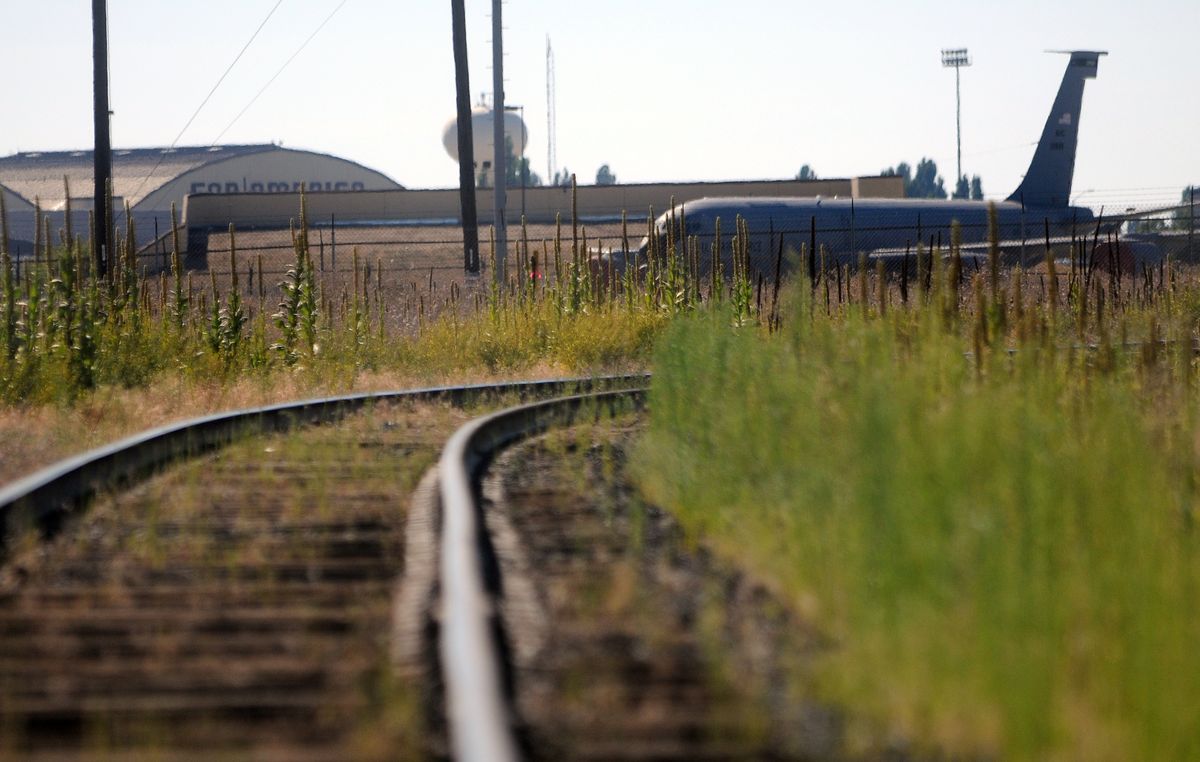New Geiger rail line on track
Officials hope spur that avoids Fairchild will help development

In near 100-degree heat last week, Benito Velasquez and three co-workers pounded into place the S-shaped clips that hold steel rails to concrete ties.
A ping reverberated down the track with every sledgehammer blow. Three or four swings, and the clip was in place. Repeat on every one of 8,450 ties. By mid-November, said Mike Schrake, general superintendent for contractor H&H Engineering and Construction Inc., trains that now cross Fairchild Air Force Base will instead head toward Cheney.
The base will be more secure, and Spokane County will have what government and business officials hope will be a valuable new economic development tool. Almost 400 jobs in steel fabrication and other industry based in Airway Heights already depend on the Geiger Spur. The new track and adjacent open land could attract more businesses, in particular those that want a facility where goods can be transferred from train to truck, or vice versa.
The Washington Department of Transportation set aside $860,000 to start environmental and other work on a transloading facility, which could cost between $3.2 million and $4.5 million.
The county Office of Economic Development and the former Spokane Area Economic Development Council estimated jobs and investment might increase tenfold if the spur were redirected and more land for industry made available.
The nearby Spokane International Airport adds another cargo option.
But first, grades must be cut, track laid, switches installed and crossings signaled. H&H, of Stockton, Calif., was awarded the work contract with a bid of $5.1 million.
The process starts with grading, which on the plains has involved relatively little cutting and backfilling. The underlying basalt has been blasted away in only one spot. Culverts straddle watercourses, including the vestige of an old canal that once tapped Silver Lake.
The soil is tamped, covered with a heavy, felt-like “stabilization blanket,” then covered with 12 inches of gravel and six more of ballast. The graders are equipped with Global Positioning System technology that allows them to grade to within 1 1/4 inch of specifications. To further refine the level, surveyor stakes are placed every 100 feet that are accurate to within an eighth of an inch.
Spokane County construction engineer Paul Lennemann said the final grade cannot deviate more than three-eighths of an inch from specifications. In a few places, he said, extra excavation has been necessary because of an unexpected layer of slick clay.
Lennemann, who usually supervises road construction, said some aspects of the process are unfamiliar.
“I’ve never laid new rail before,” he said. “It’s a whole new language.”
Ties and rails follow the graders. The concrete ties were produced at the CXT Inc. plant in Spokane Valley. The rails were salvaged from track pulled up near Curlew, Lennemann said.
Velasquez, Yubal Gonzales, Sergeo Ibarro and Jaime Arnulfo, all with H&H, tie the rails down by hand. Schrake said there is almost as much hand labor involved if machines are used. Ballast dumped between the rails completes the track-laying.
When all the track is in place, including a 1,236-foot siding, switches and crossings at Thorpe Road and Highway 902, a tamper will lift and align the rails for the last time. The tamper arrives Monday.
“We’re moving right along,” said Schrake, whose last job with H&H was laying rail in downtown Phoenix for its new mass-transit system.
The new rail will tie into the Palouse River and Coulee City line near Medical Lake. That line joins the BNSF Railway track at Cheney.
The county will own the new track. Western Railroads will continue to be the operator.
Assistant County Engineer Chad Coles, who has been shepherding the Geiger project, said the county is already testing the track across Fairchild for hazardous materials, with the hope the rail, ties and ballast can be recycled after removal. That work will be bid next year.
In the meantime, he said, the new spur is shaping up well.
“It looks like we have a railroad here,” he said.